Project Management Methodologies: PRINCE2 and Waterfall
VerifiedAdded on 2020/03/23
|8
|1641
|69
Report
AI Summary
This report examines two prominent project management methodologies: PRINCE2 and Waterfall. The report begins by highlighting the importance of adapting project management methodologies to meet the demands of various industries, such as IT services and manufacturing, to stay competitive. It then delves into the specifics of each methodology, discussing the structured approach, defined responsibilities, and advantages of PRINCE2, including its predictability and standardization. The report also addresses some limitations of PRINCE2 such as lack of leadership, inability to provide specialist aspects and detailed techniques, change management in this methodology is difficult as PRINCE2 is procedure oriented and focused on comprehensive planning and also heavy documentation needs more time. The Waterfall methodology is then explored, detailing its sequential phases and emphasizing its simplicity and high visibility. The report also points out the limitations of the Waterfall methodology like not permitting scope changes, not permitting for any type of business requirement changes, there is no working product until the completion of the project and unable to handle the unidentified risks easily. The report concludes by summarizing that PRINCE2 is a structured, stage-oriented approach while Waterfall is a traditional linear model, ultimately aiding in the selection of the most appropriate methodology for specific project needs and business goals.
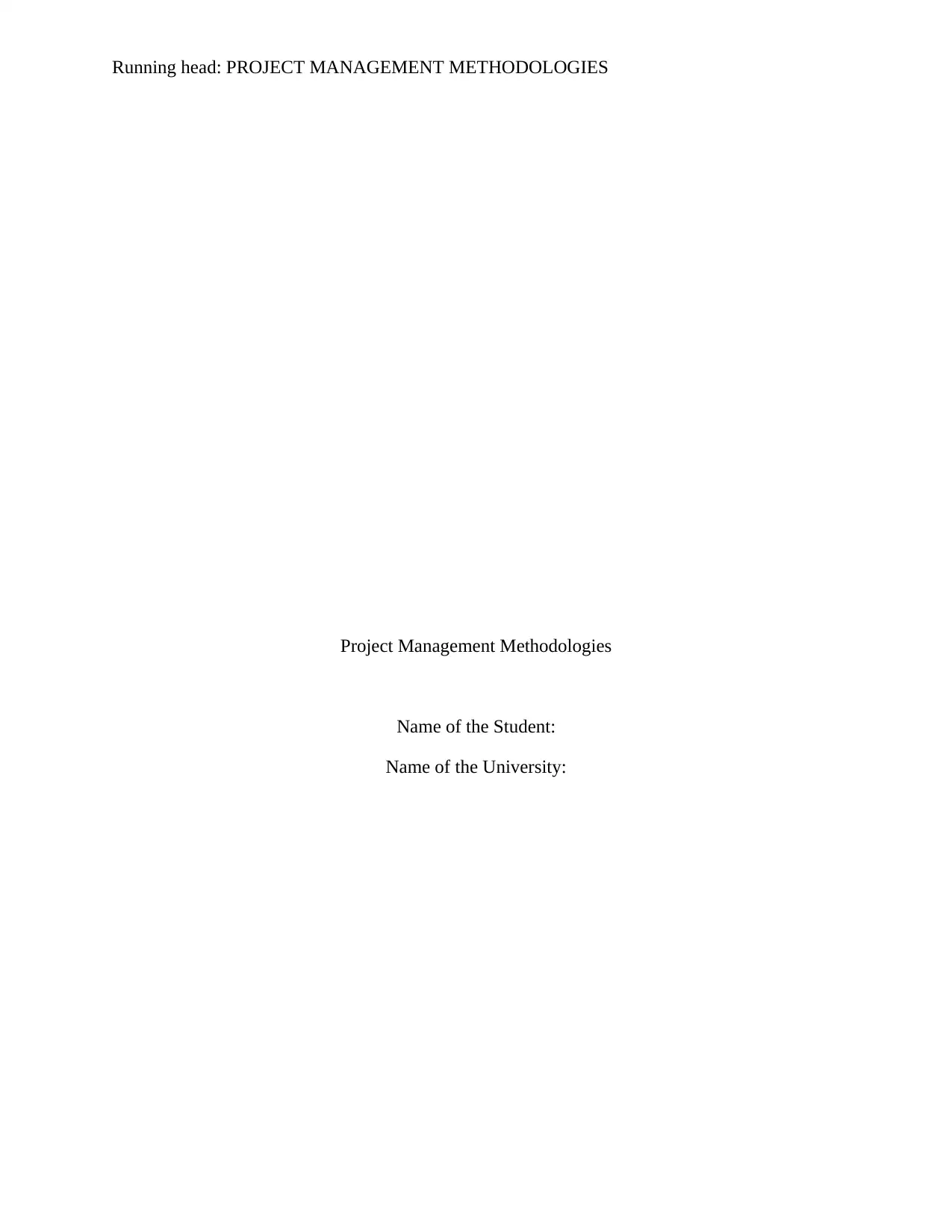
Running head: PROJECT MANAGEMENT METHODOLOGIES
Project Management Methodologies
Name of the Student:
Name of the University:
Project Management Methodologies
Name of the Student:
Name of the University:
Paraphrase This Document
Need a fresh take? Get an instant paraphrase of this document with our AI Paraphraser
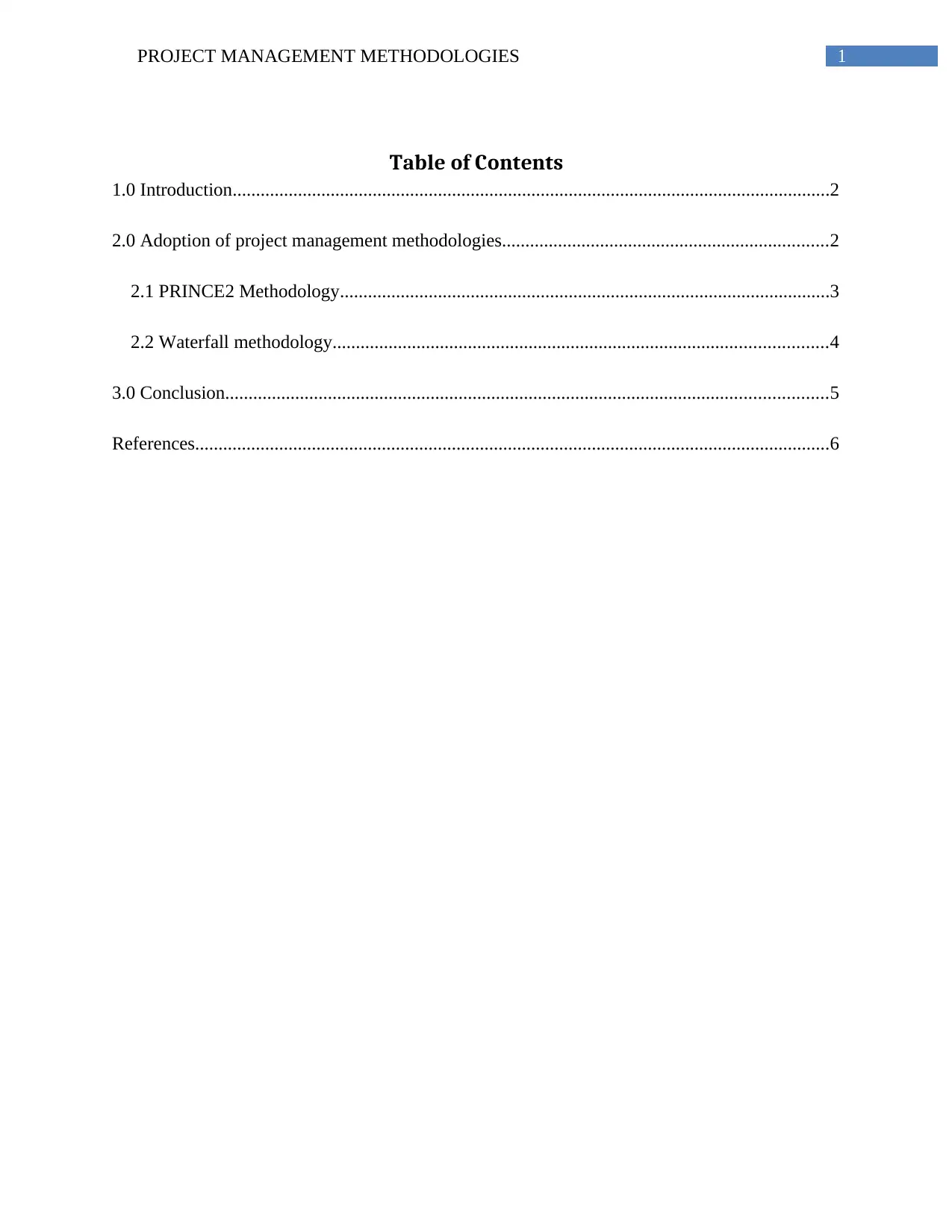
1PROJECT MANAGEMENT METHODOLOGIES
Table of Contents
1.0 Introduction................................................................................................................................2
2.0 Adoption of project management methodologies......................................................................2
2.1 PRINCE2 Methodology.........................................................................................................3
2.2 Waterfall methodology..........................................................................................................4
3.0 Conclusion.................................................................................................................................5
References........................................................................................................................................6
Table of Contents
1.0 Introduction................................................................................................................................2
2.0 Adoption of project management methodologies......................................................................2
2.1 PRINCE2 Methodology.........................................................................................................3
2.2 Waterfall methodology..........................................................................................................4
3.0 Conclusion.................................................................................................................................5
References........................................................................................................................................6
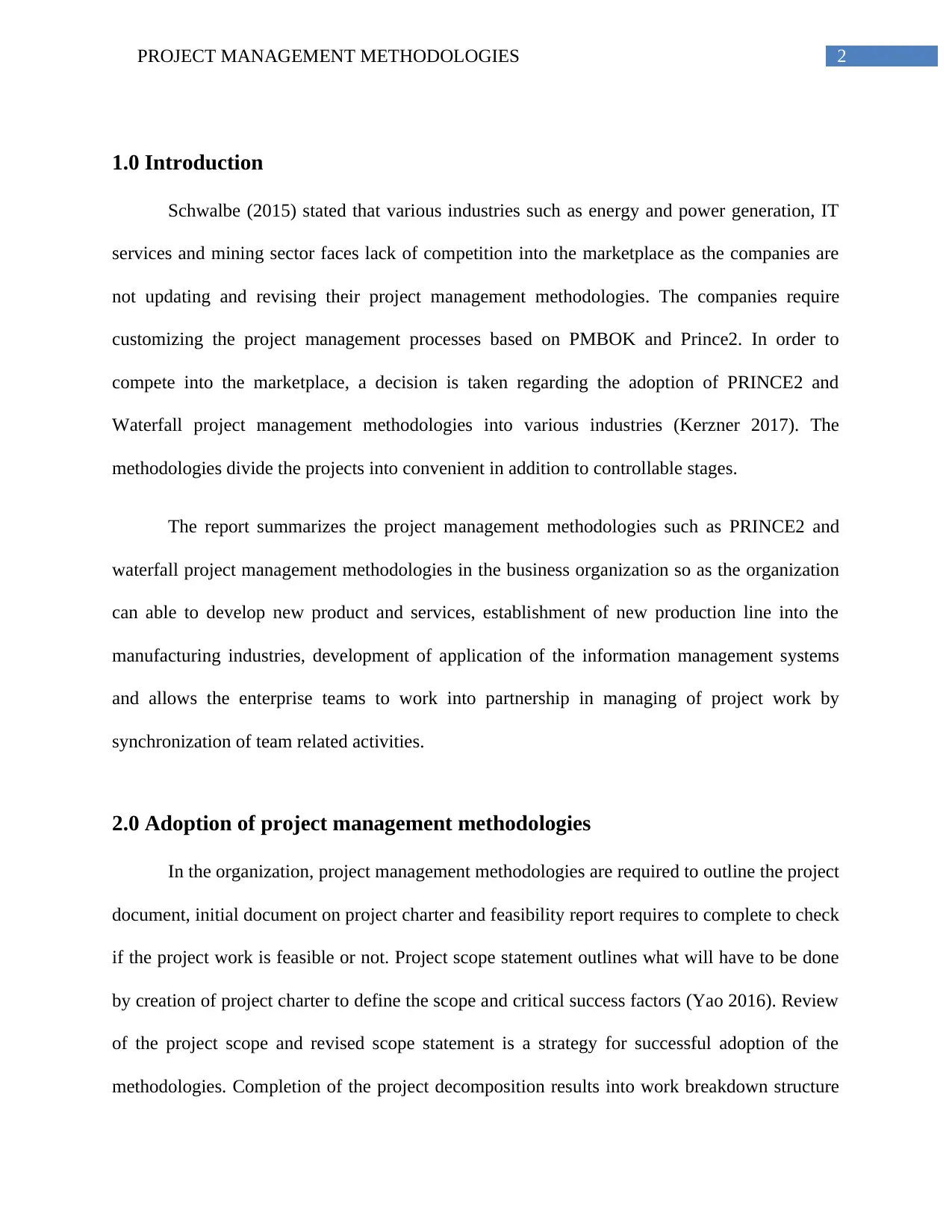
2PROJECT MANAGEMENT METHODOLOGIES
1.0 Introduction
Schwalbe (2015) stated that various industries such as energy and power generation, IT
services and mining sector faces lack of competition into the marketplace as the companies are
not updating and revising their project management methodologies. The companies require
customizing the project management processes based on PMBOK and Prince2. In order to
compete into the marketplace, a decision is taken regarding the adoption of PRINCE2 and
Waterfall project management methodologies into various industries (Kerzner 2017). The
methodologies divide the projects into convenient in addition to controllable stages.
The report summarizes the project management methodologies such as PRINCE2 and
waterfall project management methodologies in the business organization so as the organization
can able to develop new product and services, establishment of new production line into the
manufacturing industries, development of application of the information management systems
and allows the enterprise teams to work into partnership in managing of project work by
synchronization of team related activities.
2.0 Adoption of project management methodologies
In the organization, project management methodologies are required to outline the project
document, initial document on project charter and feasibility report requires to complete to check
if the project work is feasible or not. Project scope statement outlines what will have to be done
by creation of project charter to define the scope and critical success factors (Yao 2016). Review
of the project scope and revised scope statement is a strategy for successful adoption of the
methodologies. Completion of the project decomposition results into work breakdown structure
1.0 Introduction
Schwalbe (2015) stated that various industries such as energy and power generation, IT
services and mining sector faces lack of competition into the marketplace as the companies are
not updating and revising their project management methodologies. The companies require
customizing the project management processes based on PMBOK and Prince2. In order to
compete into the marketplace, a decision is taken regarding the adoption of PRINCE2 and
Waterfall project management methodologies into various industries (Kerzner 2017). The
methodologies divide the projects into convenient in addition to controllable stages.
The report summarizes the project management methodologies such as PRINCE2 and
waterfall project management methodologies in the business organization so as the organization
can able to develop new product and services, establishment of new production line into the
manufacturing industries, development of application of the information management systems
and allows the enterprise teams to work into partnership in managing of project work by
synchronization of team related activities.
2.0 Adoption of project management methodologies
In the organization, project management methodologies are required to outline the project
document, initial document on project charter and feasibility report requires to complete to check
if the project work is feasible or not. Project scope statement outlines what will have to be done
by creation of project charter to define the scope and critical success factors (Yao 2016). Review
of the project scope and revised scope statement is a strategy for successful adoption of the
methodologies. Completion of the project decomposition results into work breakdown structure
⊘ This is a preview!⊘
Do you want full access?
Subscribe today to unlock all pages.

Trusted by 1+ million students worldwide
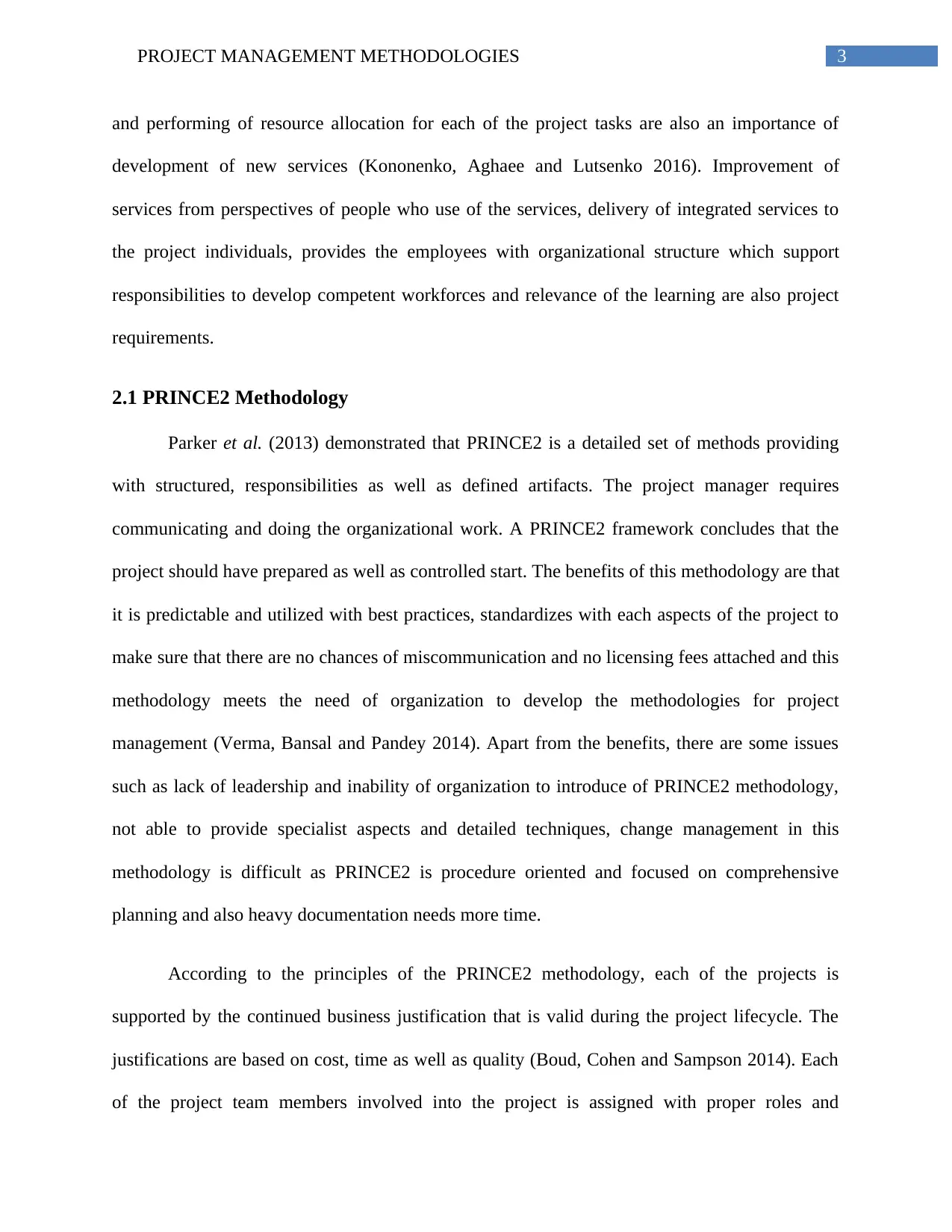
3PROJECT MANAGEMENT METHODOLOGIES
and performing of resource allocation for each of the project tasks are also an importance of
development of new services (Kononenko, Aghaee and Lutsenko 2016). Improvement of
services from perspectives of people who use of the services, delivery of integrated services to
the project individuals, provides the employees with organizational structure which support
responsibilities to develop competent workforces and relevance of the learning are also project
requirements.
2.1 PRINCE2 Methodology
Parker et al. (2013) demonstrated that PRINCE2 is a detailed set of methods providing
with structured, responsibilities as well as defined artifacts. The project manager requires
communicating and doing the organizational work. A PRINCE2 framework concludes that the
project should have prepared as well as controlled start. The benefits of this methodology are that
it is predictable and utilized with best practices, standardizes with each aspects of the project to
make sure that there are no chances of miscommunication and no licensing fees attached and this
methodology meets the need of organization to develop the methodologies for project
management (Verma, Bansal and Pandey 2014). Apart from the benefits, there are some issues
such as lack of leadership and inability of organization to introduce of PRINCE2 methodology,
not able to provide specialist aspects and detailed techniques, change management in this
methodology is difficult as PRINCE2 is procedure oriented and focused on comprehensive
planning and also heavy documentation needs more time.
According to the principles of the PRINCE2 methodology, each of the projects is
supported by the continued business justification that is valid during the project lifecycle. The
justifications are based on cost, time as well as quality (Boud, Cohen and Sampson 2014). Each
of the project team members involved into the project is assigned with proper roles and
and performing of resource allocation for each of the project tasks are also an importance of
development of new services (Kononenko, Aghaee and Lutsenko 2016). Improvement of
services from perspectives of people who use of the services, delivery of integrated services to
the project individuals, provides the employees with organizational structure which support
responsibilities to develop competent workforces and relevance of the learning are also project
requirements.
2.1 PRINCE2 Methodology
Parker et al. (2013) demonstrated that PRINCE2 is a detailed set of methods providing
with structured, responsibilities as well as defined artifacts. The project manager requires
communicating and doing the organizational work. A PRINCE2 framework concludes that the
project should have prepared as well as controlled start. The benefits of this methodology are that
it is predictable and utilized with best practices, standardizes with each aspects of the project to
make sure that there are no chances of miscommunication and no licensing fees attached and this
methodology meets the need of organization to develop the methodologies for project
management (Verma, Bansal and Pandey 2014). Apart from the benefits, there are some issues
such as lack of leadership and inability of organization to introduce of PRINCE2 methodology,
not able to provide specialist aspects and detailed techniques, change management in this
methodology is difficult as PRINCE2 is procedure oriented and focused on comprehensive
planning and also heavy documentation needs more time.
According to the principles of the PRINCE2 methodology, each of the projects is
supported by the continued business justification that is valid during the project lifecycle. The
justifications are based on cost, time as well as quality (Boud, Cohen and Sampson 2014). Each
of the project team members involved into the project is assigned with proper roles and
Paraphrase This Document
Need a fresh take? Get an instant paraphrase of this document with our AI Paraphraser
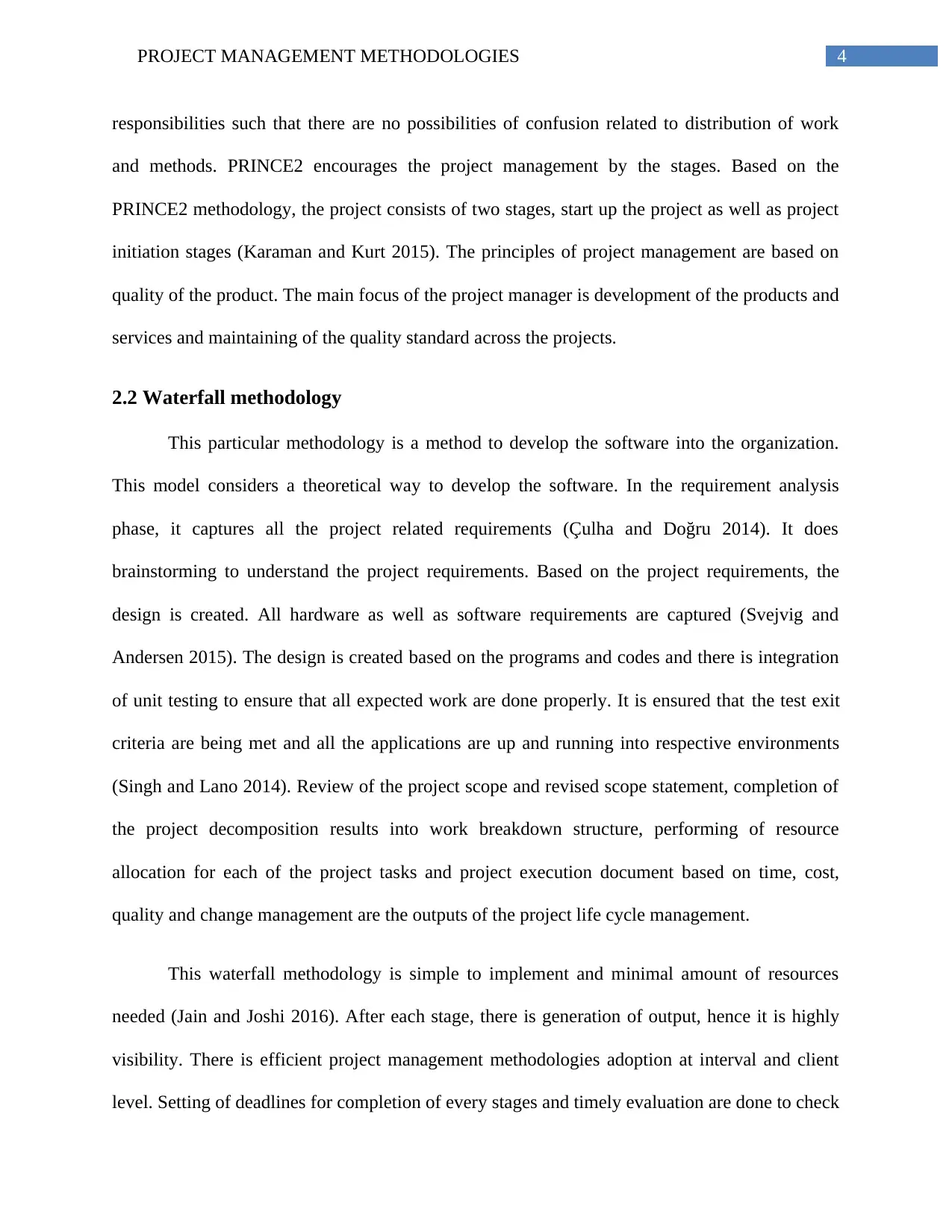
4PROJECT MANAGEMENT METHODOLOGIES
responsibilities such that there are no possibilities of confusion related to distribution of work
and methods. PRINCE2 encourages the project management by the stages. Based on the
PRINCE2 methodology, the project consists of two stages, start up the project as well as project
initiation stages (Karaman and Kurt 2015). The principles of project management are based on
quality of the product. The main focus of the project manager is development of the products and
services and maintaining of the quality standard across the projects.
2.2 Waterfall methodology
This particular methodology is a method to develop the software into the organization.
This model considers a theoretical way to develop the software. In the requirement analysis
phase, it captures all the project related requirements (Çulha and Doğru 2014). It does
brainstorming to understand the project requirements. Based on the project requirements, the
design is created. All hardware as well as software requirements are captured (Svejvig and
Andersen 2015). The design is created based on the programs and codes and there is integration
of unit testing to ensure that all expected work are done properly. It is ensured that the test exit
criteria are being met and all the applications are up and running into respective environments
(Singh and Lano 2014). Review of the project scope and revised scope statement, completion of
the project decomposition results into work breakdown structure, performing of resource
allocation for each of the project tasks and project execution document based on time, cost,
quality and change management are the outputs of the project life cycle management.
This waterfall methodology is simple to implement and minimal amount of resources
needed (Jain and Joshi 2016). After each stage, there is generation of output, hence it is highly
visibility. There is efficient project management methodologies adoption at interval and client
level. Setting of deadlines for completion of every stages and timely evaluation are done to check
responsibilities such that there are no possibilities of confusion related to distribution of work
and methods. PRINCE2 encourages the project management by the stages. Based on the
PRINCE2 methodology, the project consists of two stages, start up the project as well as project
initiation stages (Karaman and Kurt 2015). The principles of project management are based on
quality of the product. The main focus of the project manager is development of the products and
services and maintaining of the quality standard across the projects.
2.2 Waterfall methodology
This particular methodology is a method to develop the software into the organization.
This model considers a theoretical way to develop the software. In the requirement analysis
phase, it captures all the project related requirements (Çulha and Doğru 2014). It does
brainstorming to understand the project requirements. Based on the project requirements, the
design is created. All hardware as well as software requirements are captured (Svejvig and
Andersen 2015). The design is created based on the programs and codes and there is integration
of unit testing to ensure that all expected work are done properly. It is ensured that the test exit
criteria are being met and all the applications are up and running into respective environments
(Singh and Lano 2014). Review of the project scope and revised scope statement, completion of
the project decomposition results into work breakdown structure, performing of resource
allocation for each of the project tasks and project execution document based on time, cost,
quality and change management are the outputs of the project life cycle management.
This waterfall methodology is simple to implement and minimal amount of resources
needed (Jain and Joshi 2016). After each stage, there is generation of output, hence it is highly
visibility. There is efficient project management methodologies adoption at interval and client
level. Setting of deadlines for completion of every stages and timely evaluation are done to check
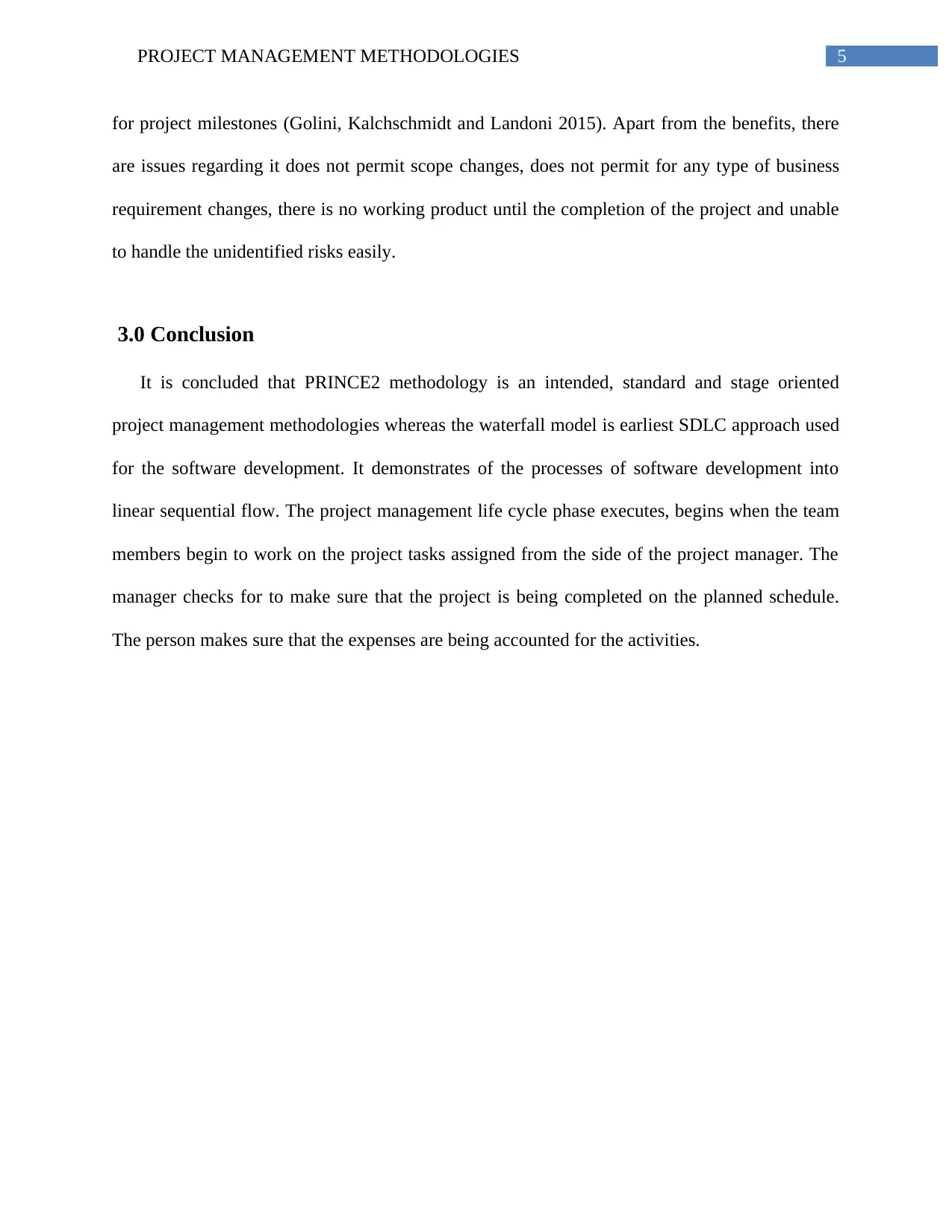
5PROJECT MANAGEMENT METHODOLOGIES
for project milestones (Golini, Kalchschmidt and Landoni 2015). Apart from the benefits, there
are issues regarding it does not permit scope changes, does not permit for any type of business
requirement changes, there is no working product until the completion of the project and unable
to handle the unidentified risks easily.
3.0 Conclusion
It is concluded that PRINCE2 methodology is an intended, standard and stage oriented
project management methodologies whereas the waterfall model is earliest SDLC approach used
for the software development. It demonstrates of the processes of software development into
linear sequential flow. The project management life cycle phase executes, begins when the team
members begin to work on the project tasks assigned from the side of the project manager. The
manager checks for to make sure that the project is being completed on the planned schedule.
The person makes sure that the expenses are being accounted for the activities.
for project milestones (Golini, Kalchschmidt and Landoni 2015). Apart from the benefits, there
are issues regarding it does not permit scope changes, does not permit for any type of business
requirement changes, there is no working product until the completion of the project and unable
to handle the unidentified risks easily.
3.0 Conclusion
It is concluded that PRINCE2 methodology is an intended, standard and stage oriented
project management methodologies whereas the waterfall model is earliest SDLC approach used
for the software development. It demonstrates of the processes of software development into
linear sequential flow. The project management life cycle phase executes, begins when the team
members begin to work on the project tasks assigned from the side of the project manager. The
manager checks for to make sure that the project is being completed on the planned schedule.
The person makes sure that the expenses are being accounted for the activities.
⊘ This is a preview!⊘
Do you want full access?
Subscribe today to unlock all pages.

Trusted by 1+ million students worldwide
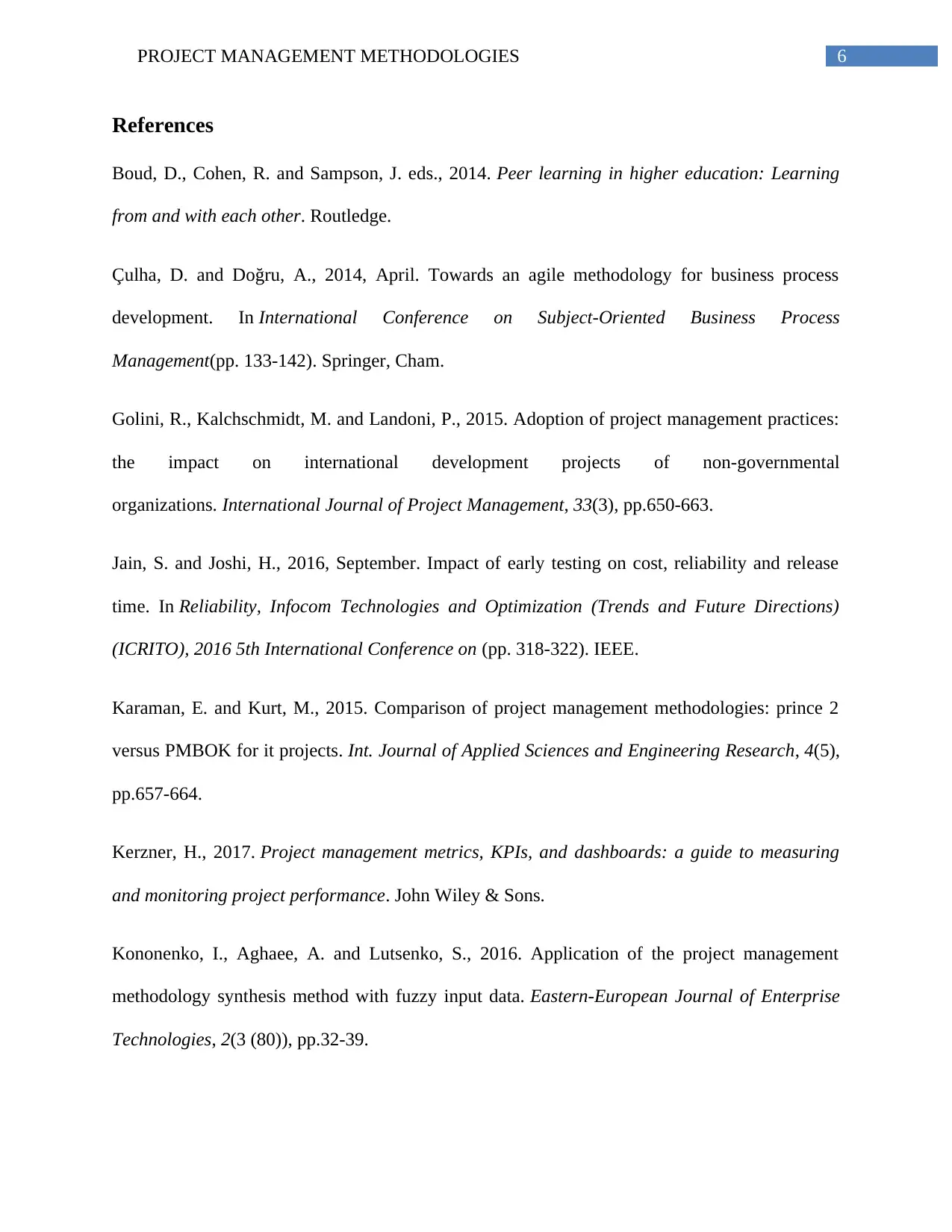
6PROJECT MANAGEMENT METHODOLOGIES
References
Boud, D., Cohen, R. and Sampson, J. eds., 2014. Peer learning in higher education: Learning
from and with each other. Routledge.
Çulha, D. and Doğru, A., 2014, April. Towards an agile methodology for business process
development. In International Conference on Subject-Oriented Business Process
Management(pp. 133-142). Springer, Cham.
Golini, R., Kalchschmidt, M. and Landoni, P., 2015. Adoption of project management practices:
the impact on international development projects of non-governmental
organizations. International Journal of Project Management, 33(3), pp.650-663.
Jain, S. and Joshi, H., 2016, September. Impact of early testing on cost, reliability and release
time. In Reliability, Infocom Technologies and Optimization (Trends and Future Directions)
(ICRITO), 2016 5th International Conference on (pp. 318-322). IEEE.
Karaman, E. and Kurt, M., 2015. Comparison of project management methodologies: prince 2
versus PMBOK for it projects. Int. Journal of Applied Sciences and Engineering Research, 4(5),
pp.657-664.
Kerzner, H., 2017. Project management metrics, KPIs, and dashboards: a guide to measuring
and monitoring project performance. John Wiley & Sons.
Kononenko, I., Aghaee, A. and Lutsenko, S., 2016. Application of the project management
methodology synthesis method with fuzzy input data. Eastern-European Journal of Enterprise
Technologies, 2(3 (80)), pp.32-39.
References
Boud, D., Cohen, R. and Sampson, J. eds., 2014. Peer learning in higher education: Learning
from and with each other. Routledge.
Çulha, D. and Doğru, A., 2014, April. Towards an agile methodology for business process
development. In International Conference on Subject-Oriented Business Process
Management(pp. 133-142). Springer, Cham.
Golini, R., Kalchschmidt, M. and Landoni, P., 2015. Adoption of project management practices:
the impact on international development projects of non-governmental
organizations. International Journal of Project Management, 33(3), pp.650-663.
Jain, S. and Joshi, H., 2016, September. Impact of early testing on cost, reliability and release
time. In Reliability, Infocom Technologies and Optimization (Trends and Future Directions)
(ICRITO), 2016 5th International Conference on (pp. 318-322). IEEE.
Karaman, E. and Kurt, M., 2015. Comparison of project management methodologies: prince 2
versus PMBOK for it projects. Int. Journal of Applied Sciences and Engineering Research, 4(5),
pp.657-664.
Kerzner, H., 2017. Project management metrics, KPIs, and dashboards: a guide to measuring
and monitoring project performance. John Wiley & Sons.
Kononenko, I., Aghaee, A. and Lutsenko, S., 2016. Application of the project management
methodology synthesis method with fuzzy input data. Eastern-European Journal of Enterprise
Technologies, 2(3 (80)), pp.32-39.
Paraphrase This Document
Need a fresh take? Get an instant paraphrase of this document with our AI Paraphraser
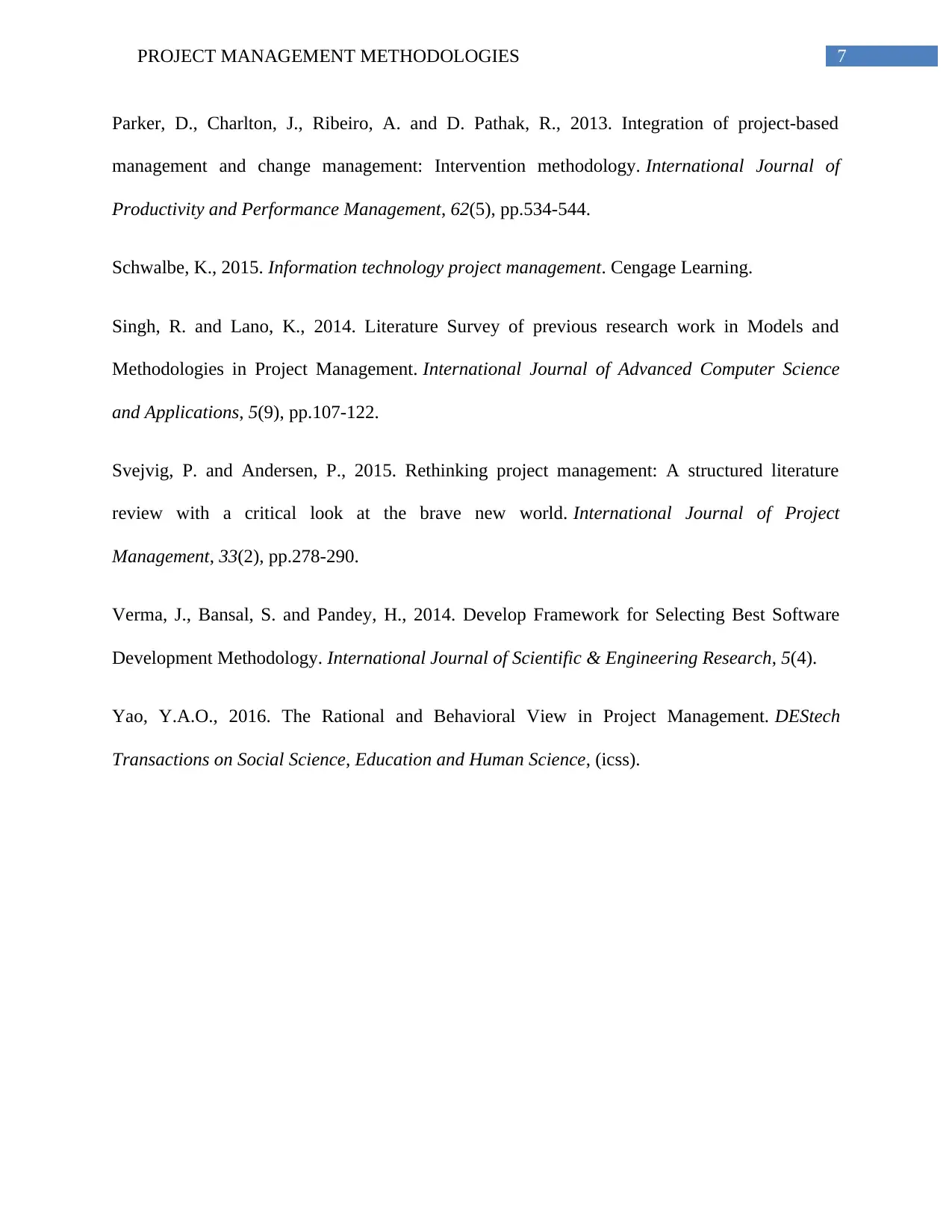
7PROJECT MANAGEMENT METHODOLOGIES
Parker, D., Charlton, J., Ribeiro, A. and D. Pathak, R., 2013. Integration of project-based
management and change management: Intervention methodology. International Journal of
Productivity and Performance Management, 62(5), pp.534-544.
Schwalbe, K., 2015. Information technology project management. Cengage Learning.
Singh, R. and Lano, K., 2014. Literature Survey of previous research work in Models and
Methodologies in Project Management. International Journal of Advanced Computer Science
and Applications, 5(9), pp.107-122.
Svejvig, P. and Andersen, P., 2015. Rethinking project management: A structured literature
review with a critical look at the brave new world. International Journal of Project
Management, 33(2), pp.278-290.
Verma, J., Bansal, S. and Pandey, H., 2014. Develop Framework for Selecting Best Software
Development Methodology. International Journal of Scientific & Engineering Research, 5(4).
Yao, Y.A.O., 2016. The Rational and Behavioral View in Project Management. DEStech
Transactions on Social Science, Education and Human Science, (icss).
Parker, D., Charlton, J., Ribeiro, A. and D. Pathak, R., 2013. Integration of project-based
management and change management: Intervention methodology. International Journal of
Productivity and Performance Management, 62(5), pp.534-544.
Schwalbe, K., 2015. Information technology project management. Cengage Learning.
Singh, R. and Lano, K., 2014. Literature Survey of previous research work in Models and
Methodologies in Project Management. International Journal of Advanced Computer Science
and Applications, 5(9), pp.107-122.
Svejvig, P. and Andersen, P., 2015. Rethinking project management: A structured literature
review with a critical look at the brave new world. International Journal of Project
Management, 33(2), pp.278-290.
Verma, J., Bansal, S. and Pandey, H., 2014. Develop Framework for Selecting Best Software
Development Methodology. International Journal of Scientific & Engineering Research, 5(4).
Yao, Y.A.O., 2016. The Rational and Behavioral View in Project Management. DEStech
Transactions on Social Science, Education and Human Science, (icss).
1 out of 8
Related Documents
Your All-in-One AI-Powered Toolkit for Academic Success.
+13062052269
info@desklib.com
Available 24*7 on WhatsApp / Email
![[object Object]](/_next/static/media/star-bottom.7253800d.svg)
Unlock your academic potential
Copyright © 2020–2025 A2Z Services. All Rights Reserved. Developed and managed by ZUCOL.





